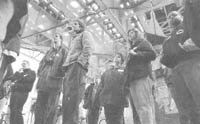Blue Line beauty in eye of
buffs
By Brett McNeil
Tribune staff reporter
Date of Publication: October 27, 2003
Source: Chicago
Tribune

Tour takers get a look under
the "L" tracks at Damen station on the Blue Line. Sunday's
tour of stations along the line drew 40 people who paid $33
each and rode a charter train. For a larger view, click
here.
(Tribune photo by Jose More)
Copyright © 2003, Chicago
Tribune
|
Like a long, dark winter or a prairie landscape, the Blue Line is an
acquired taste.
Still, the Chicago Transit Authority's no-frills rapid transit
line to the West and Northwest Sides has its adherents.
"It's eclectic, that's for sure," said Graham Garfield. "It's a
patchwork, of a lot of different types of construction combined into
one line."
A CTA planner who maintains the online archives at
www.chicago-l.org, Garfield helped organize the first historic tour
of Chicago's "L" stations five years ago, and in the years since they
have become sellouts at $33 a head. The tour Sunday, conducted on a
four-car charter train, focused on the oft-overlooked subtleties of
Blue Line station design.
"One of the things people always comment on is that the subway
platforms in Chicago are so austere," Garfield told a group of 40
people waiting inside the LaSalle Street station. "But remember, at
the time they were designed [the 1930s], ornamentation was
old-fashioned."
Rather than replicating the fancy iron grillwork found on portions
of the Blue Line's elevated platforms, designers of the subway
stations opted for an Art Moderne style: clean ceramic-tile walls,
stark cement floors and informational signs written in a lean, crisp
typeface called Futura.
John Craib-Cox, an architectural historian, came along as a guide
to aesthetics and general trivia. During the four-hour tour he
explained such finer points as how to gauge the age of a rivet on an
"L" support beam and why stations built during the 1960s are easier
to clean than those built in the 1890s. Mostly, though, he stuck to
building styles.
On the LaSalle Street platform, Craib-Cox pointed to the station's
arched ceiling and said, "Although this is very simple, it's got a
unity of construction to it."
People on the tour, many of them repeat customers, nodded in
agreement.
Tony Coppoletta, 24, of the city's West Lawn neighborhood was on
his fourth "L" tour.
"Since I was a teenager and they opened the Orange Line to my part
of the city, I've been interested in the `L,'" Coppoletta said. "For
me it was an enabler. It allowed me to see the rest of the city."
Oak Lawn resident Rod Balla, 52, and his son Ryan, 16, were taking
their second tour in as many years. Balla explained that their
interest in rapid transit history is sort of futuristic.
"We believe that the automobile will be history in about 70
years," he said.
Even on a train full of self-described "rail fans," Balla's
prediction was a little out there. Most simply said they like
learning about Chicago's mass-transit culture.
Kathy Fink, 39, of Winnetka brought her son, Andrew, 13, for his
first tour Sunday. Even as chaperon to an unabashed train buff, Fink
said she found herself interested in an everyday place like the
Belmont station.
"I didn't realize [the Chicago architectural firm]
Skidmore, Owings and Merrill was involved in the design," she said
after Garfield explained the station's history. "I think a lot of
people rushing through don't notice, either."
Art Gilfand, 48, of Lakeview was on his third tour Sunday--and
plans to be back next year.
"After riding these trains for the last 40 years, I've been on
every line, on every inch of track in the city," he said. "I'm
obsessed with it, and I'm just glad to see other people equally
obsessed with it."
Copyright (c) 2003, Chicago Tribune
